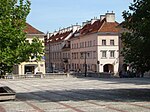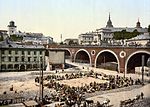Bednarska Street, Warsaw
Poland road stubsStreets in WarsawWarsaw geography stubs

The Bednarska Street in Warsaw, Poland, is a street in Warsaw's Śródmieście borough, and is the narrowest street in Warsaw (5.3 m). The street received its current name before the year 1743, stemming from its upper part consisting of houses inhabited by artisans, probably mainly by coopers (bednarz being the Polish word for cooper). Officially, the name was given in 1770.
Excerpt from the Wikipedia article Bednarska Street, Warsaw (License: CC BY-SA 3.0, Authors, Images).Bednarska Street, Warsaw
Bednarska, Warsaw Śródmieście (Warsaw)
Geographical coordinates (GPS) Address Nearby Places Show on map
Geographical coordinates (GPS)
| Latitude | Longitude |
|---|---|
| N 52.245277777778 ° | E 21.018055555556 ° |
Address
Bednarska 14
00-310 Warsaw, Śródmieście (Warsaw)
Masovian Voivodeship, Poland
Open on Google Maps










